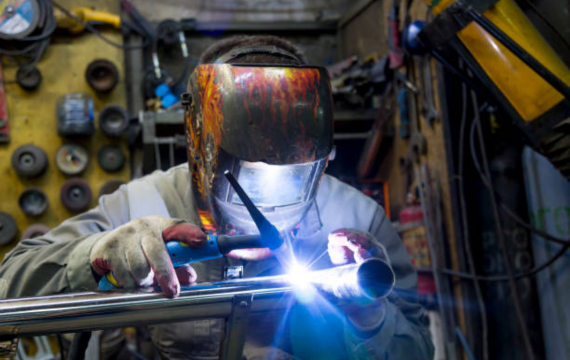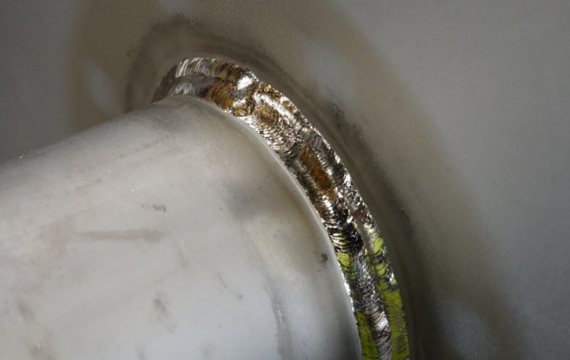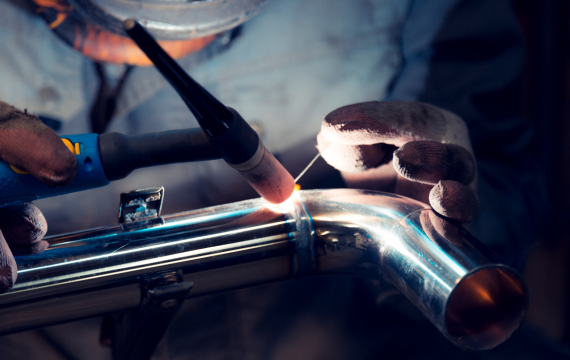Titanium is a unique material which makes welding process a little challenging for many metallurgists.
In this guide, we will take you through a detailed process on how to weld titanium. From properties that makes welding titanium possible, detailed procedures, precautions to tips – by the end of this guide, you should be able to complete the process easily.
Let’s dive right in:
Why Weld Titanium?
You weld titanium because this metal is very strong, lightweight, and can also resist corrosion. Therefore is ideal for aerospace, medical and high-performance industries.

Properties that Make Titanium Welded
The following are the properties of titanium that will make it appropriate for your welding;
- Corrosion Resistance: Titanium does not corrode easily, not even in environments that are unfavorable such as salty water that you could come across.
- High Melting Point: The next characteristic is that the metal has a relatively high potential to melt at about 1670°C (3035°F). This makes it capable of withstanding very high temperatures during its welding without either melting or distorting.
- High Strength: Titanium is also unique in that it does not loose its strength of structure when you weld it.
- Lightweight: You will note that titanium is lighter than most other metals and this is as a result of its material density.
- Heat Resistance: In using titanium, you do not have to worry about its structural failure due to heated climate because it is heat resistant.
- Low Thermal Expansion: Titanium exhibits a very low coefficient of thermal expansion. Therefore does not expand much when heated making the welded parts to be dimensionally stable.
- Oxidation Resistance: Titanium has the ability to react with oxygen during the process of welding to form an oxide layer that protects it against oxidation process.
Challenges in Titanium Welding Process
When practicing welding, some of the difficulties that you are likely to experience are:
- Oxidation Risk: Titanium is highly reactive with oxygen and due to this, it forms a thick oxide layer when exposed to air during the welding process. Like any other welding process, you need to shield the weld region using an inert gas. Preferably Argon to minimize chances of oxidation that badly affects the weld.
- Contamination Sensitivity: Titanium is very susceptible to contamination by oils, dirt and moisture. Any dirt no matter how small that gets in contact with the materials to be welded can cause flaws on the weld.Therefore, the surfaces and the tools which will be used have to be neat.
- High Reactivity at High Temperatures: Titanium reacts with oxygen, nitrogen and hydrogen at high temperatures and this leads to contamination of the material. Welding always has to occur in a specific environment that may include a shielding gas. This is so that any undesired reaction does not occur and thus results in a poor quality of the weld.
- High Melting Point:With titanium’s high melting point, you will use more energy and specialized equipment in the course of welding. This can be more difficult and challenging. Because in this process heat treatment is used and the task is to prevent overheating or warping of the material.

How to Prepare Titanium for Welding
Before welding titanium, it is first necessary to familiarize the surface properly so here are some steps that you need to undergo. Clean with an all-stainless steel brush or a specific titanium brush for removing any oxide layers, dusts and oils.
Ensure that you wear a pair of nitrile gloves for the simple reason that oils on your skin can contaminate the mix.
Subsequently, wash the affected area with a proper solvent that may be acetone, making sure that there is no residue on the selected surface.Before welding, guarantee that the environment you are working in is clean and there are no debris.
Titanium is highly reactive, and a perfect environment has to be established before welding that includes shielding the weld area with argon gas. This is in order to avoid contact with oxygen, nitrogen and hydrogen. Last of all, sanitize and do not use the same set of tools to work on other materials as this may affect the quality of titanium.
Steps on How to Weld Titanium
Here is how you should proceed in order to weld titanium:
Step 1: Prepare the Metal
First of all, you have to clean the titanium surface with a brush of stainless steel, or even better, titanium, to eliminate dust formation. It must be clean of any oxide layers, dirt or grease before its use in measuring.
Step 2: Set Up a Controlled Environment
Make sure that the environment where you work is clean. It is recommended that you weld titanium in an inert atmosphere. Therefore, using argon to cover areas you will be welding is critical.
This will prevent contamination.
Step 3: Purge the Underside
If you are welding thin Titanium or structures where the underside of the joint is exposed you have to turn on the backside Argon gas. This will counter-check oxidation and will also help in making a clean and perfect weld on both sides.
Step 4: Select the Right Filler Material
In choosing the filler rod, you should use the same grade of titanium for welding. This will help you in providing you with a consistent and strong weld, which you aspire to have as a welder.
Step 5: Choose the Correct Welding Technique
For titanium, your best bet for welding is the gas tungsten arc welding which is broadly referred to as GTAW or TIG welding.In this method, you have control over heat and the welds produced are clean and accurate due to the reactivity of the titanium.
Step 6: Weld with Precision
Do not be tempted to apply excess pressure when welding as this reduces the steadiness of a hand. Tilt the torch 15-20 degrees and while so doing ensure that the weld pool is protected by argon to its entirety.
Step 7: Post-Weld Treatment
Allow the weld to cool in air, but within the protected environment. Observe it for its color – shades of silver to straw are preferred. If the color is blue or grey, it means that the sample is contaminated.
Step 8: Final Cleaning
After the weld is done, it is also important to clean the area to remove any form of contaminant that may exist.

MIG Welding Titanium vs. TIG Welding Titanium
So here is what you should know when you compare MIG and TIG welding of the titanium material:
- Speed: If your welding work needs to be done fast, then MIG welding is faster than TIG welding and hence useful in large-scale projects. For instance, if you need to be more meticulous and accurate, then TIG welding is more useful.
- Skill Level:If you are a beginner then MIG welding is better for you because in TIG welding you take much time to practice it.
- Heat Control: MIG welding is more likely to overheat the material and is very risky when welding titanium. This is because it damages it as compared to TIG where there is much control of heat produced.
- Cost: The costs associated with MIG welding are in general lower than for TIG welding which needs specific apparatus and shielding gas.
- Process Difficulty: MIG welding is easy not too complex and because of that you will find it easy. While TIG welding is complex and requires more precision as compared to MIG welding.
- Precision and Shielding: MIG welding is much less precise and does not offer the same level of protection as TIG welding, which offers excellent argon cover. This is so as to minimize contamination of the titanium.

Tips on Welding Titanium Tube/Pipe
The following are some of the most important tips when welding titanium tubes or pipes:
- Clean thoroughly: Contamination will destroy your weld. Clean the surface of titanium thoroughly from impurities before welding.
- Take it easy on the Heat: You need to have precise control over your heat zones so as not to warp or otherwise mess with how strong you need that weld. For optimum heat management, think about using a water-cooled torch.
- Get Excellent Gas Coverage: Titanium is highly susceptible to gases such as oxygen and nitrogen. Make use of argon as a shielding gas to avert contamination. An exceptional gas regulator ensures steady gas flow.
- Use a TIG Machine with the Right Features: It is preferable to employ TIG for welding of titanium. To regulate heat and accomplish a clean weld, you will have to use a machine with a high-frequency start, pulse function, and foot pedal control.
- Maintain a narrow temperature setting: To minimize overheating, you need to keep the heat set to a restricted area. Use a narrow temperature setting on your torch and work swiftly to avoid heat accumulation.
Why is Titanium Difficult to Weld
It is very challenging to weld titanium due to its affinity to react with oxygen, nitrogen or hydrogen at high temperatures. These are gaseous in nature and during the process of welding, the titanium becomes heated and absorbs these gases resulting in contamination. Thereby, making the weld weaker and embrittled.
This, however, must be avoided by ensuring that you use an inert gas such as argon to cover the weld area completely.Further, titanium has low thermal conductivity hence a high tendency of heat buildup at weld zones causing warping or burn-through to occur. This makes the heat control to be very critical something that also makes the process to be very much complicated.
Titanium welding is an even more challenging process because of the necessity of maintaining a clean and controlled environment and using specialized equipment. In addition, more complex equipment is needed as compared to steel welding.
FAQS
1. Is Titanium difficult to Weld?
Yes, titanium is a difficult material to weld due to the characteristic of the material itself where it is highly reactive at high temperatures. Thus, welding has to be done with very good heat control, good shielding and an environment free from contamination. Also, has to be free from embrittlement.
2. Which Welding is used for Titanium?
TIG welding (Tungsten Inert Gas) is one of the most frequently used techniques in welding titanium. Even as other methods like MIG welding are being perfected for titanium, TIG nevertheless remains popular because of its accuracy and efficiency nature.
3. Can Titanium be Welded together?
Yes, welding of titanium and its alloys is allowed but you must employ filler materials of the same type of titanium grade. The American Welding Society has a set of specifications that offers various requirements which include the recommended filler wire for differing titanium alloys.
4. Is Titanium Welded with AC or DC?
Titanium is typically welded with direct current, not alternating current, which restricts you to using only direct current type tungsten electrodes.
5. What Rod can you use to Weld Titanium?
For welding purposes of titanium, it is recommended that you use the titanium TIG rods as filler material of the same grade as the one being welded. Depths are observed in front of these rods which are inserted into the weld joint to contribute material and to increase the sizes of the weld.
6. Can Titanium be Cold Welded?
Yes, you can cold weld titanium. This process takes place when you have to press two clean and ductile titanium surfaces together at a high pressure. This is so as to join them without needing to apply heat.
7. Why is Titanium so difficult to Weld?
Welding titanium is challenging because it combines with oxygen and nitrogen when its temperature is greater than 400°C, and this makes it brittle. This contamination can make the weld zone prone to cracking, equally not all welding processes are suitable for titanium.
8. Is Welding Titanium Expensive?
Yes, welding of titanium is expensive. It is more expensive than TIG welding because titanium is expensive and the filler rods required are very expensive.In addition to the more complex torch and larger amounts of gas used.
Conclusion
As you can see, welding titanium can be a challenging process. However, with the right equipment, you can easily weld titanium.
Remember, welding is one of the many ways you can fabricate titanium, other options include:




